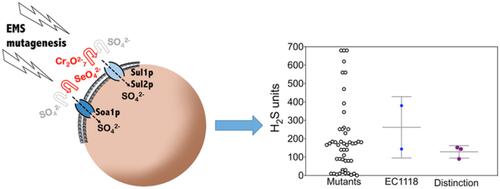Our official English website, www.x-mol.net, welcomes your
feedback! (Note: you will need to create a separate account there.)
Sulfate transport mutants affect hydrogen sulfide and sulfite production during alcoholic fermentation
Yeast ( IF 2.2 ) Pub Date : 2021-02-09 , DOI: 10.1002/yea.3553 Michelle E Walker 1 , Jin Zhang 1 , Krista M Sumby 1, 2 , Andrea Lee 1 , Anne Houlès 3 , Sijing Li 1 , Vladimir Jiranek 1, 2
Yeast ( IF 2.2 ) Pub Date : 2021-02-09 , DOI: 10.1002/yea.3553 Michelle E Walker 1 , Jin Zhang 1 , Krista M Sumby 1, 2 , Andrea Lee 1 , Anne Houlès 3 , Sijing Li 1 , Vladimir Jiranek 1, 2
Affiliation

|
Hydrogen sulfide is a common wine fault, with a rotten-egg odour, which is directly related to yeast metabolism in response to nitrogen and sulfur availability. In grape juice, sulfate is the most abundant inorganic sulfur compound, which is taken up by yeast through two high-affinity sulfate transporters, Sul1p and Sul2p, and a low affinity transporter, Soa1p. Sulfate contributes to H2S production under nitrogen limitation, by being reduced via the Sulfur Assimilation Pathway (SAP). Therefore, yeast strains with limited H2S are highly desirable. We report on the use of toxic analogues of sulfate following ethyl methane sulfate treatment, to isolate six wine yeast mutants that produce no or reduced H2S and SO2 during fermentation in synthetic and natural juice. Four amino acid substitutions (A99V, G380R, N588K and E856K) in Sul1p were found in all strains except D25-1 which had heterozygous alleles. Two changes were also identified in Sul2p (L268S and A470T). The Sul1p (G380R) and Sul2p (A470T) mutations were chosen for further investigation as these residues are conserved amongst SLC26 membrane proteins (including sulfate permeases). The mutations were introduced into EC1118 using Crispr cas9 technology and shown to reduce accumulation of H2S and do not result in increased SO2 production during fermentation of model medium (chemically defined grape juice) or Riesling juice. The Sul1p (G380R) and Sul2p (A470T) mutations are newly reported as causal mutations. Our findings contribute to knowledge of the genetic basis of H2S production as well as the potential use of these strains for winemaking and in yeast breeding programmes.
中文翻译:

硫酸盐转运突变体影响酒精发酵过程中硫化氢和亚硫酸盐的产生
硫化氢是一种常见的葡萄酒缺陷,带有臭鸡蛋味,这与酵母代谢对氮和硫的可用性做出反应直接相关。在葡萄汁中,硫酸盐是最丰富的无机硫化合物,酵母通过两种高亲和力硫酸盐转运蛋白 Sul1p 和 Sul2p 以及低亲和力转运蛋白 Soa1p 吸收硫酸盐。在氮限制下,硫酸盐通过硫同化途径 (SAP) 被还原,从而促进 H 2 S 的产生。因此,非常需要具有有限H 2 S 的酵母菌株。我们报告了硫酸乙酯处理后硫酸盐的有毒类似物的使用,以分离六种不产生或减少 H 2 S 和 SO 2 的葡萄酒酵母突变体在合成和天然果汁发酵过程中。除了具有杂合等位基因的 D25-1 外,在所有菌株中都发现了 Sul1p 中的四个氨基酸取代(A99V、G380R、N588K 和 E856K)。在 Sul2p(L268S 和 A470T)中也发现了两个变化。选择 Sul1p (G380R) 和 Sul2p (A470T) 突变进行进一步研究,因为这些残基在 SLC26 膜蛋白(包括硫酸盐通透酶)中是保守的。使用 Crispr cas9 技术将突变引入 EC1118,并显示可减少 H 2 S 的积累并且不会导致 SO 2增加模型培养基(化学成分确定的葡萄汁)或雷司令汁发酵过程中的生产。Sul1p (G380R) 和 Sul2p (A470T) 突变是新报告的因果突变。我们的发现有助于了解 H 2 S 生产的遗传基础以及这些菌株在酿酒和酵母育种计划中的潜在用途。
更新日期:2021-02-09
中文翻译:

硫酸盐转运突变体影响酒精发酵过程中硫化氢和亚硫酸盐的产生
硫化氢是一种常见的葡萄酒缺陷,带有臭鸡蛋味,这与酵母代谢对氮和硫的可用性做出反应直接相关。在葡萄汁中,硫酸盐是最丰富的无机硫化合物,酵母通过两种高亲和力硫酸盐转运蛋白 Sul1p 和 Sul2p 以及低亲和力转运蛋白 Soa1p 吸收硫酸盐。在氮限制下,硫酸盐通过硫同化途径 (SAP) 被还原,从而促进 H 2 S 的产生。因此,非常需要具有有限H 2 S 的酵母菌株。我们报告了硫酸乙酯处理后硫酸盐的有毒类似物的使用,以分离六种不产生或减少 H 2 S 和 SO 2 的葡萄酒酵母突变体在合成和天然果汁发酵过程中。除了具有杂合等位基因的 D25-1 外,在所有菌株中都发现了 Sul1p 中的四个氨基酸取代(A99V、G380R、N588K 和 E856K)。在 Sul2p(L268S 和 A470T)中也发现了两个变化。选择 Sul1p (G380R) 和 Sul2p (A470T) 突变进行进一步研究,因为这些残基在 SLC26 膜蛋白(包括硫酸盐通透酶)中是保守的。使用 Crispr cas9 技术将突变引入 EC1118,并显示可减少 H 2 S 的积累并且不会导致 SO 2增加模型培养基(化学成分确定的葡萄汁)或雷司令汁发酵过程中的生产。Sul1p (G380R) 和 Sul2p (A470T) 突变是新报告的因果突变。我们的发现有助于了解 H 2 S 生产的遗传基础以及这些菌株在酿酒和酵母育种计划中的潜在用途。











































 京公网安备 11010802027423号
京公网安备 11010802027423号